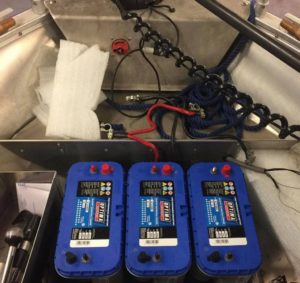 A boat battery is something that you need if you have a boat. Often, it’s also a power source that propels the boat forward. But even if you have a boot without an engine, or the motor is not powered by electricity, a boat battery can still be of use to you. You need a DC source to power your fishfinder, your depth finder and other equipment on board.
A boat battery is something that you need if you have a boat. Often, it’s also a power source that propels the boat forward. But even if you have a boot without an engine, or the motor is not powered by electricity, a boat battery can still be of use to you. You need a DC source to power your fishfinder, your depth finder and other equipment on board.
Most fans of trolling fishing have long picked their favorite batteries.
Some use car batteries because of their low cost. But they aren’t really good long-term. Most of the time, an automotive battery loses its capacity by the end of the season, and it’s not even usable after that. A typical cheap lead-acid automotive battery is suitable for feeding the starter with a large current for a brief period, so you could actually crank the engine. However, it’s not capable of keeping the voltage steady, and once fully discharged, that’s it, the battery is done for. Now, the batteries for electric cars (known as traction batteries) are different, but automotive traction batteries are quite heavy and less practical to use on a boat, to say nothing of the fact they are expensive and overkill for that purpose.
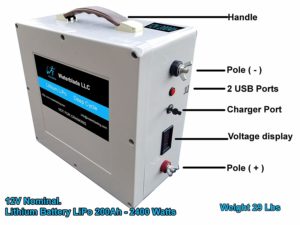
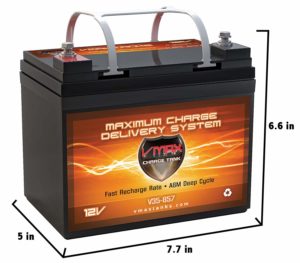
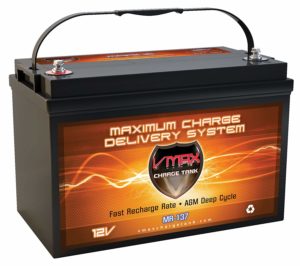
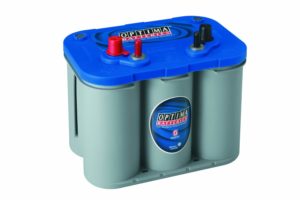
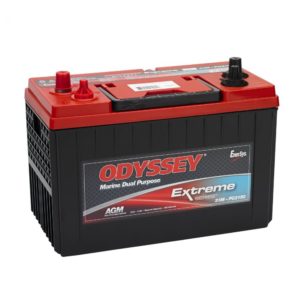
Top 5 Best Boat Traction Batteries in 2019
112 Lithium Battery — Most Efficient Battery
Typically, you wouldn’t use this battery to feed a boat motor. That’s understandable, the battery is not marine grade, and it’s expensive. But it has a massive advantage over most marine batteries: it’s Li-Po battery rather than lead-acid. The implications are huge. To give you an example, this battery has a net weight of just 29 pounds. That’s comparable to low capacity boat traction batteries, except that the capacity of this battery is overwhelming.
The battery is reasonably durable, it has a decent operating temperature range, and if it weren’t for the price, it would be the best battery of the best. As it is, though, I don’t think many people will be using this battery.
- High Capacity AND Low Weight. Not a combination you see often.
- Fault-tolerant charging. Since it’s a LiPo battery, it’s more forgiving than a gel cell lead acid battery.
- Decent operating range. You can be confident that this battery won't let you down even if the water is freezing. But I suppose you won't be able to sail much if it's freezing.
- Expensive. At least three times the price of a battery of similar capacity.
2VMAXTANKS VMAX V35-857 12 Volt 35AH AGM Battery — Low Profile Battery
Now, this is a battery to use if you have a typical low power trolling motor. While the capacity of 35AH isn’t much, it’s still good for about an hour of full speed for your motor. It is specifically made for trolling motors, and it’s as good as it gets.
It’s an AGM lead-acid battery, so you can safely turn the battery. Unlike wet cell batteries, it’s safe.
You can also get it as part of a battery kit.
- Low Weight. Carrying it around won’t be hard.
- Deep Cycle. Important as far as lead acid batteries go.
- Made for Trolling Motors. You know it’s suitable for trolling if it’s made for trolling.
- Low capacity. While the capacity has to be sacrificed for low weight and price, it’s still quite low.
- Made for low thrust motors. If you have an engine that has a thrust of more than 50lb, you're out of luck.
3VMAX MR137-120 AGM Sealed Marine AGM Battery — Best Overall
It’s a pretty massive battery, but it also has a capacity of 120 AH. Not only that, but it’s also built to last for years. I’m not sure if it’s not just a marketing technique, but this boat battery is said to last for up to 10 years. It’s hard to test it within a reasonable timeframe, though, so we only have the words of the manufacturer to rely on.
The biggest drawback of this battery is its weight. It’s heavy, but there’s not much that can be done about that. At least 75 pounds is more or less reasonable, and if you need that much capacity, you can carry it. Any fisher would find a use for this battery.
- High Capacity. If you have a powerful trolling motor and you want to squeeze every HP it can offer, you want this battery, so you don't run out of juice in the middle of your trip.
- Deep Cycle. A given for a VMAX battery.
- Made for Trolling Motors. Best for 50-110 lb thrust.
- Heavy. Carrying this battery around is a chore.
4Optima Batteries 8016-103 D34M BlueTop — Cranking-capable Battery
If you need a battery to use in tandem with an outboard or inboard motor, an automotive battery could be a good choice. However, they are terribly bad at giving a constant level of voltage and current, and without feedback from the alternator, the charge of any automotive battery deteriorates quickly. That means you won’t be able to use all your fishfinders and other equipment, unless on the move.
What to do?
Get this dual purpose battery. You can still use this battery to power your equipment, but it’s also good for cranking the engine. You can get by with just a boat battery if you have an outboard motor, but a cranking-capable battery is a must for inboard motors.
Is it any good as a boat battery, though? Well, it’s heavy, and its capacity leaves much to be desired, and it’s also expensive… I think you understand what I mean. If you don’t need it for cranking, there’s no need to buy it. But if you think it might be of use to you, it’s volumes better than any dedicated car battery or boat battery.
- Dual Purpose battery. If you need that cranking power, you have it. Rock solid 750 CCA and 870 MCA.
- Doesn’t have to be mounted in a specific position. It doesn’t matter how you mount this battery. It’s going to pump out all the charge just fine.
- Abuse-resistant. The battery is extra durable and vibration resistant.
- Overpriced for a boat battery. Sure, you can feed a starter with this battery, but if you’re going to use it to feed your trolling motor, it’s a waste of money. You’re never using it for starting the engine, to begin with.
- Heavy. It’s too heavy for a low capacity battery.
5Odyssey 31M-PC2150ST-M TROLLING Thunder Marine Dual Purpose Battery — High Capacity Dual Purpose Battery
It’s sold as an automotive battery, and looking at its features, it is. However, it’s not just any automotive battery. This battery can give a large current over a short time, true, but it can also provide a small current for hours and days without deteriorating.
It’s probably the best battery all around, but only if you need a battery to start the engine, now or in the future. If you don’t have a use for that high CCA number, there’s no point in paying the price.
If you do choose it, you will be pleasantly surprised with the fast recharge time and its ability to handle deep discharge.
- Dual Purpose battery. The largest cold cranking ampere I’ve seen in a while: 1150 CCA!
- Fast charge. It only takes up to 6 hours to get this battery fully charged from zero.
- Significant operating temperature range. From -40 degrees Fahrenheit (and also Celsius) to 176 degrees Fahrenheit (80 degrees Celsius). You can use it in your car if you wish.
- Abuse-resistant. It’s not surprising, considering the other features.
- Trolling Battery. Even though it’s automotive, it’s made with trolling motors in mind.
- Overkill for a boat battery. It’s an automotive battery that doubles as a boat battery, not the other way around.
- Heavy. Despite its weight, it has a good capacity.
Buyer’s Guide
Marine Batteries Only
The first thing I must mention here is that the battery you choose must be a traction battery, not a cranking battery designed for cars. I keep on reiterating well-known facts, but maybe some people from my audience don’t know that. The point is that traction batteries take a long time to discharge while maintaining a constant voltage level. They won’t be damaged by a deep discharge because of the lead plates, if they even have any in the first place, won’t be destroyed because of that. Unlike a conventional cranking battery that feeds the starter with a large current and discharges fast in the process to be soon recharged by the alternator. You will not get far with that kind of battery, and you won’t be on the move for long. If you get to the point the battery is fully discharged, you may as well get it recycled.So yeah, marine/boat/traction batteries only.Capacity and Weight
The second or even most essential parameter is the battery capacity. It is the defining characteristic of any battery. Why? That’s obvious, more amps per hour mean longer travel time, a more powerful trolling motor, more distance covered.It’s nice and everything, but more capacity usually means more weight as well. Or more money. Or both. And you can’t do much about that. So while more capacity is always better, you need to stop at some point to make it practical.So, what should the battery capacity be? That depends on how you plan to use it. A battery that has a large capacity can have more mass than your entire boat, sometimes weighing even as much as 100 pounds. VMAX MR197 12 Volt 200AH Battery is a good example of that, and it’s one of the lighter batteries of that caliber.The weight may not seem like a huge deterrent, but when you’re going to fish small ponds and lakes, especially where you can’t get your car close to the shore, you have to carry the boat and the battery to the water by yourself. It can be a short distance, but it can also be a hundred feet, five hundred feet, or even half a mile. I can tell you right away, carrying a 100 pounds battery for the sake of two hours of trolling is not fun.For that kind of scenario, I highly recommend a small boat battery, 45 AH at most. It will suffice for feeding a low power trolling motor at its full power for an hour and a half. That is more than enough for shallow and small water bodies where the use of a trolling motor is most justified. That’s the kind of scenario where you look at the weight first and everything else second. Besides, weaker batteries have lower weight, and you won’t have to pay extra for them.However, a low capacity battery won’t really get you far. If that’s what you require, you need a battery with a larger capacity. If you are going fishing a large lake or river, and you’re going to be trolling all day, a small power source will obviously not be enough. Besides, if you have a powerful trolling motor, then you need an appropriately capacious battery. A 45 AH battery will not last long at 12 knots. For that kind of scenario, you need something like 80 — 120 AH.Finally, you really like your electric motor, and you plan on using it a lot, you may have to buy a 200 AH battery, or even a spare battery for longer trips.Summarizing, you want a low-weight battery with a smaller capacity for fishing in-shore or for sailing small water bodies, especially if you have an inflatable boat. For feeding a powerful electric motor, you will generally get a more capacious batteryWhat’s Inside
This is a question you need to know the answer to, and not because you could sate idle curiosity. The technology utilized in the production of your battery is vital for its performance and usability.Traditionally, rechargeable batteries are lead and acid based. Wet cell batteries are the most popular and cheap since they contain an acidic electrolyte and lead plates. However, that design makes them extremely vulnerable.AGM batteries are technically the same. Nevertheless, they are sealed, and they can take the abused wet cell batteries cannot take.Gel cell batteries use silica additives to improve the performance further. They are less vulnerable, they are incredibly deep-cycle, and they perform better than any other type of LA batteries. You can roll them over, you can drop them overboard, nothing will spill out of the battery, even if the case is broken. However, they are incredibly vulnerable to overvoltage. Charging them is a pain, and you can easily damage a gel cell battery. I advise using smart chargers specifically made to charge gel cell batteries. Not only is it justified, but it’s also necessary.Optimal Parameters
When making my top list of the best batteries, I was guided by the most optimal parameters suitable for most anglers’ needs. Nevertheless, I cannot say that they are ideal for everyone. At least each fifth of my readers will want to get a battery that has slightly different parameters, better adjusted for their needs.So here are the parameters I believe are optimal for boat batteries.- Deep Cycle
- Minimal battery capacity: 100 amps
- Wide operating temperature range: 0F to 80F
- Reinforced case
- Vibration Resistant
- Low Weight
